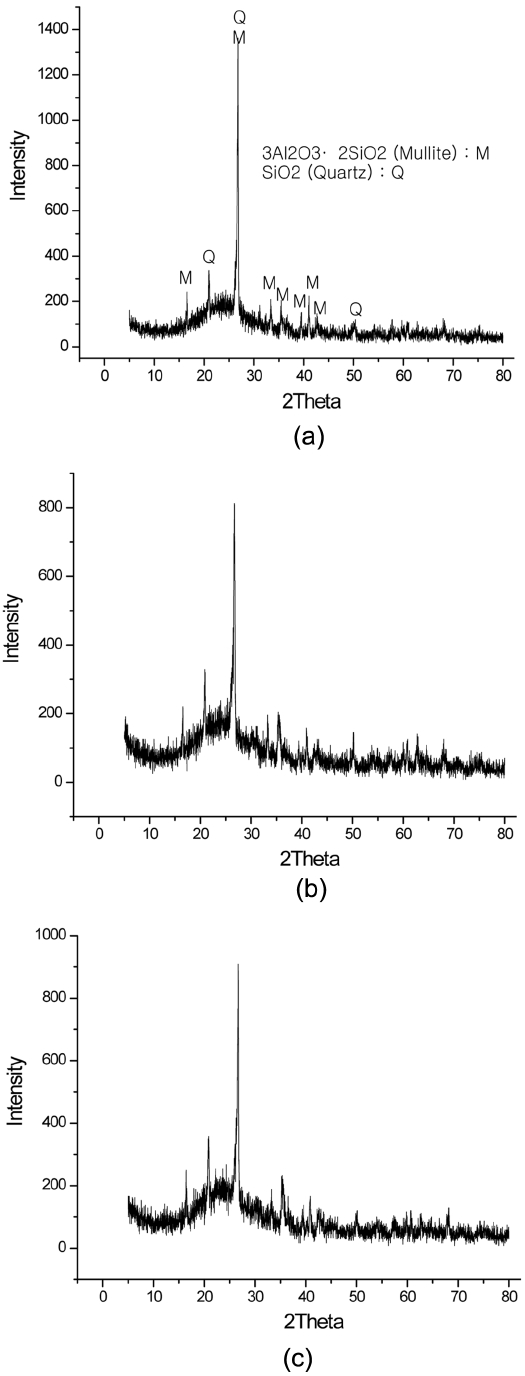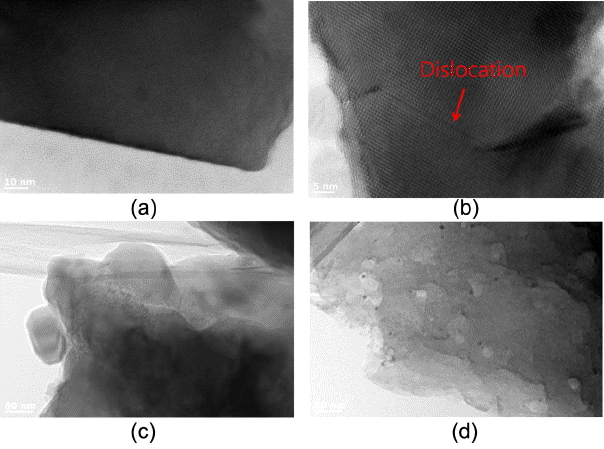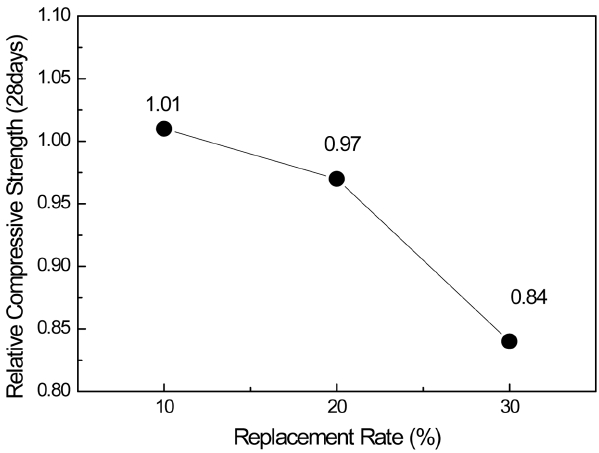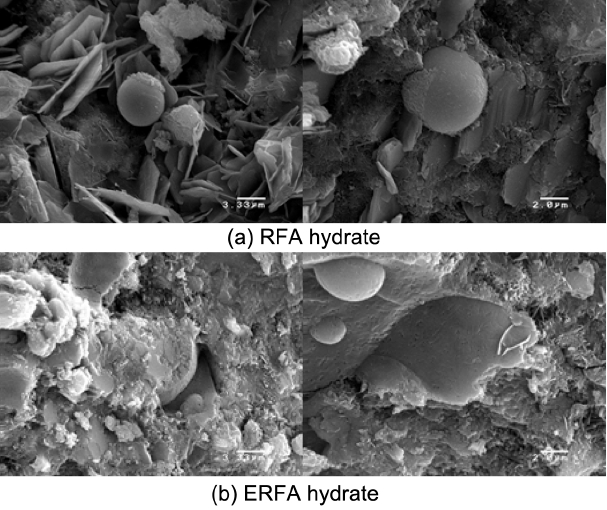Jeong, Chu, Yi, Seo, and Kwon: A Study on the Manufacturing of Energetically-Modified Reject Fly Ash and the Characteristics of Mortar
Abstract
Energetically-modified material using reject fly ash (RFA), generated from thermal power plants, was manufactured to investigate the effect of the material on the physical and chemical characteristics of cement mortar. In order to modify reject fly ash, a vibration mill was used. Particle size, grain shape, and crystal structure of the ash were analyzed. Then, the compressive strength of the mortar using energetically-modified reject fly ash (ERFA) was measured. Microstructure and X-ray diffraction (XRD) patterns were also used in the analysis. As the replacement rate of ERFA increased, the value of the compressive strength tended to decrease. However, it was found that the compressive strength values of 7 and 28 days-cured specimens were higher than those of conventional ordinary Portland cement (OPC) mortar with 10 % replacement rate condition.
Key words: Mortar, Concrete, Thermal power plant, Fly ash, Energetically-modified powder
1. Introduction
Coal is being used in a large quantity as an energy source in the major power stations in Korea since 1960s. Around 29% of domestic power is generated from coal-fired power plants, and fly ashes byproduct is also generated more than around 8 million tons/year. 1) According to the sixth basic plan for the power supply reported in the year 2014, around KRW 28,000 billion is planned to be spent as an invest for coal-fired power generation facility during the period (2013 ~ 2017). Among these, KRW 12,000 billion is planned to be utilized for new construction of the facilities. Therefore, it is expected that fly ashes byproduct also would be increased. As a result, handling issues of the fly ashes which can not be recycled would surface. 2)
Fly ashes are discharged from boilers along with combustion gas after coal is burned, and are broadly categorized into fly ash which is captured in the dust collector and bottom ash which is a residue stacked at the bottom of the boiler. Among these, fly ash occupies at an around 80% of total coal ashes, and is currently widely being used as an admixture for concrete after going through additional sorting. In the sorting process, fly ash is separated into fine ash and reject fly ash (RFA). 2-4) RFA generally has large particles than fine ash, and has high contents of unburned carbon. Most of the fine ashes are recycled in the construction/ civil engineering fields, while reject fly ash deteriorates quality when it is applied in the mortar and concrete, thus limiting its usage. Therefore, RFA is mostly buried, which in turn can causes destruction of environment and shortage of filled ground. 5)
In this study, applicability of dry mortar was reviewed to draw a potential utilization of reject fly ashes. It is known that generally, if energetically-modified fly ash is applied in the mortar, the amount is increased than conventional use amount of fly ash. For example, a good quantity of energetically-modified fly ash is applied in the mortar in USA and Europe. 6) Activation technology crushes particle finely by imposing a shear strength or impact strength on the particles. Activation also can be done by generating crack, dislocation, and lattice defect on the particles. Activated particles improve hydration degree by consuming activation energy during hydration. In due course of hydration, particle energy would be decreased. 7) Therefore, in this study, energetically-modified reject fly ash was prepared to implement in the mortar, and physical experiment as well as analysis for the hydrate were carried out to analyze and evaluate activation degree of the energetically-modified reject fly ash.
2. Experimental Procedure
The reject fly ash generated from the Samcheonpo Thermal Power Plant (TPP), Korea South-East Power Co. Ltd., was used to prepare energetically-modified reject fly ash (ERFA). For RFA, particles were energetically modified using a vibration mill (WTVM, Ungbi, Korea), and particle size, particle form, and crystallinity were analyzed according to the grinding condition. Capacity of the grinder was 7,693 cm3, and total capacity of the bowl was fixed at 15 kg (Φ26 mm : 2 kg, 11 mm : 8 kg, 6 mm : 5 kg). For the evaluation of physical property of energetically-modified reject fly ash mortar, specimens were prepared according to the specification in KS L ISO 679 (Methods of testing cements - Determination of strength). At this time, some quantity of the cement was used by substituting it with ERFA. The specimens were cured at 23°C and relative humidity at 90% in a thermo-hygrostat for initial 24 h, and then cured under the water. Chemical composition of each raw material was analyzed by using an inductively coupled plasma spectrometer (ICP-OES 8300, Perkin Elmer, US). Particle form, surface condition, and micro-structure of hydrates were analyzed by using SEM (SM300, Topcon, Japan). Defects in the alignment of atom was checked using TEM (JEM-4010, Jeol, Japan). Crystalline properties of particle before and after grinding were analyzed by using XRD (D/MAX-3000, Rigaku, Japan).
3. Results and Discussion
3.1 Analysis of Raw Material
Table 1 presents chemical composition of reject fly ash and fine ash used in the experiment. Composition of RFA and fine ash are pretty similar, and major components were SiO 2 and Al 2O 3. Ignition loss of RFA was more than double of fine ash, and reject fly ash has far higher unburned carbon and volatile substances than fine ash. Generally, it is known that unburned carbon of fly ash absorbs AE agent when it is blended in the concrete, thus hinders inclusion of air. 8,9) Because admixture such as AE was not used in the present study, it was judged that there would not be any problem in expressing physical properties of mortar.
3.2 Preparation of Energetically-Modified Reject Fly Ash (ERFA)
Average particle size of reject fly ash by grinding time is presented in Table 2. As curding time was increased, though average particle size was decreased, reduction of particle size was gradually decreased as can be seen in Table 2. This means that as particle diameter is decreased, grinding would be difficult, which is in conformity with general grinding mechanism.
Figure 1 shows micro-structure of reject fly ash before and after grinding with a vibratory milling for one hour. Reject fly ash before grinding (b) displays a general similar sphere shape, but the sphericity was lower than the fine ash. Generally, spherical fine ash has a ball-bearing effect, which increases fluidity of the concrete and mortar. 10) However, it was found that reject fly ash (c) after grinding one hour was changed to broken sphere (angled micro-particles).
XRD patterns of reject fly ash before and after grinding are presented in Fig. 2. Generally, major crystals in the coal ash are mullite and quartz, and major peaks of these crystals are presented at an around 27°. 11) In this study, above peaks were observed at an around 27°, and major peaks were decreased under the grinding condition. At this time, peak strength in the non-grinding condition was 1363 CPS (Count/Second), and this value became decreased in a range of 808 ~ 908 lower than that CPS after grinding. However, no big difference was observed by increasing the grinding time. The reason why XRD peak strength was decreased is due to increases in the amorphous contents. Therefore, from the above results, it could be assumed that crystalline property of the reject fly ash becomes deteriorated by grinding. However, reduction of peak strength by increased grinding did not show a clear trend. Rather, peak strength was increased in some of the samples, which needs further analysis.
Figure 3 shows SEM photos for the rejected fly ash before and after grinding. In Fig. 3 (a) and (b) atomic arrangement of particles could be observed. These are representative photo obtained from crystalline particles. Therefore, it was judged that (a) and (b) are parts of quartz particle analyzed in the XRD Pattern. Especially, in photo (b), dislocation which is a type of line defects was confirmed. 12) From the photo (d), trace of falling parts of particles and many holes were found from several places inside the particles as compared with photo (c). This phenomenon might be due to the strong impact from steel balls which are the grinding media inside of vibratory mill.
Above defect can increase energetically-modified degree for the particles by making particles unstable. After that, mixed water and alkali ion move at the interface of the particle, particle changed to stable phase. That is, defect portion presented in the particle is filled by hydration, and stability is achieved. In order to fill the defects, new materials have to be produced at the defective portion. In case of cement mortar and concrete, mixed water and alkali ion move, and new hydrate should be formed at the defective portion. Ying wang et al. has expressed this process as “nucleus production effect”. 13) Further, large specific area can act as a heterogeneous nucleus producing surface that promotes sedimentation of the hydrate. Therefore, crack or holes produced during grinding can play a vital role on the production of hydrates by attributing increases in the specific area.
3.3 Strength Property of Energetically-Modified Reject Fly Ashes
Compressive strengths of mortar into which reject fly ash was substituted or used at 10% by grinding time on the third day, 7 days, and 28 days are presented in Fig. 4. As grinding time became extended to 60 min., though compressive strengths on the 3 rd, 7 th, and 28 th day were increased, this trend was followed by no great changes. Maximum compressive strength was 35.7MPa on the 3 rd day, 48.0MPa on the 7 th day, and 54.6MPa on the 28 th day during grinding for 60 min. These values were higher by 0.4MPa as compared with compressive strength of reject fly ash mortar without grinding on the 28 th day, and by 0.5MPa as compared with OPC mortar ( Fig. 5). Fig. 6 shows separate expression of compressive strength on the 28 th day by grinding time. Compressive strength was increased until grinding for 60 min., after which showed similar values. Besides, analysis results for specific surface area of reject fly ash by grinding time showed that as grinding time was increased, increases rate of the specific surface area was decreased. ( Fig. 7) Therefore, after grinding for 60 min., since changes in the specific surface area was meager, compressive strength value might have been similar. These results suggested that grinding time for 60 min. was the most effective for performance and economic feasibility of reject fly ash. Compressive strength of the mortar by mixing ratio of ERFA as compared with OPC mortar on which ERFA was not mixed on the 28 th day are presented in Fig. 8. When 10% of ERFA was substituted, mortar showed greater compressive strength than OPC mortar. The compressive strength of mortar was reduced as substitution rate was increased. This is a phenomenon occurring while producing Ca(OH) 2 which is a hydrate of cement as mixing ratio of cement was decreased. The major components of rejected fly ash SiO 2 and Al 2O 3 are major pozzolans and reacts with Ca(OH) 2, to produce calcium silicate hydrate (C-S-H gel). 14)
Above hydrates make hydrated structure more compact, attributing improvement of physical property of mortar. That is, while Ca(OH)2 which is necessary for pozzolan reaction of reject fly ash becomes lacking, thus strength becomes impaired. Further, as cement contents were decreased, decreases in the C3A and gypsum also might have affected on decreases in the strength. Therefore, it was judged that RFA substitution at 20% which exhibited similar strength with OPC mortar would be adequate in order to secure optimum physical property of mortar wherein pulverized fuel ash was used.
3.3 Analysis of Hydrates for Energetically-modified Reject Fly Ash Mortar
Contents of mixed water were fixed at 40% as against ERFA in order to analyze and evaluate hydration characteristics of cement, and then left inside thermo-hygrostat at temperature 23°C-relative humidity at 90% for one day. After that, it was cured under water. XRD analysis was conducted for the hydrates which was cured for three days and for 28 days. Fig. 9 shows XRD patterns of hydrates cured for three days and 28 days. While, Table 3 presents peak strength of Ca(OH) 2 in terms of value. In all the XRD Pattern, peaks of Ca(OH) 2, which is one of the major hydrates were found. Crystal peak of Ca(OH) 2 was presented at near 18.2˚. Apart from this, ettringite peak at near 9˚ was also observed. Above peaks are the typical hydrates which are observed in OPC hydrates. Therefore, it could be assumed that energetically-modified mixed cements prepared in this study would express similar physical properties with OPC. 15)
Ca(OH)2 peak strength of hydrates prepared by using rejected fly ash was increased from 754 to 1016 as curing duration was increased (3 days →28 days). In case of energetically-modified reject fly ash, peak strength was increased with a less degree from 646 to 700. That means, Ca(OH)2 crystalline properties of both specimens were gradually increased as curing days were extended. However, the increment of energetically-modified reject fly ash was relatively less. This phenomenon might be due to difference in the activity between reject fly ash and ERFA. Since coal ash reacts with Ca(OH)2 which is a hydrate of cement, increase and decrease of Ca(OH)2 peak strength are affected by amount of Ca(OH)2, that is involved in the pozzolan reaction. That is, the lower strength increases of hydrate of energetically-modified hydrates means the more amount of Ca(OH)2 was involved in hydration than hydrates of reject fly ash, which indicates that activation of reject fly ash by grinding is beneficial for promoting hydration.
Micro-structure of cured hydrate for seven days using reject fly ash and ERFA are presented in Fig. 10. The ash particles presented in the hydrates of reject fly ash have not been sufficiently hydrated. Some of the ash particles which were not ground were observed in the hydrates of energetically-modified reject fly ash. However, hydration was progressed to some extent in the ground particles, thereby hydrates were linked with matrix. Especially, at the fracture surface of the particles, hydration was well advanced, thus particle shape could not be observed properly. Such hydration characteristics would be important factors attributing in improving compressive strength.
4. Conclusions
Reject fly ash was prepared as energetically-modified reject fly ash (ERFA) to implement in the mortar. Physical and chemical properties of ERFA were analyzed. Further, physical experiments were performed for the ERFA mortar to review utilization of ERFA.
When reject fly ash was ground using a vibratory mill, average particle diameter became decreased as grinding time was increased. Also, it was confirmed that mechanical grinding attributed generation of cracks on the particles and defects. The compressive strength of the mortar wherein 10% of ERFA was substituted was the maximum when it was ground for 60 min. on the 28 days of curing. However, even if grinding time was further increased, strength was not improved further. When ERFA, which was ground for 60 min., was tested according to substitution rates (10%, 20%, and 30%), its compressive strength above of OPC mortar could be achieved. Besides, when ERFA was substituted at 20%, similar physical properties with OPC mortar could be obtained. The improvement in the compressive strength of ERFA mortar might be due to excellent pozzolan reactivity, which could be sufficiently validated by observing crystalline property and micro-structure.
Acknowledgments
The present study was carried out with the support of research fund from the Land, Infrastructure and Transport Technology Regional Specialization Project (15RDRP-B103390-03), the Korea Ministry of Land, Infrastructure, and Transport. We would like to extend our sincere gratitude for the support.
Fig. 1
SEM micrograph: (a) fly ash (b) reject fly ash (c) 60min ground reject fly ash. 
Fig. 2
XRD patterns of (a) reject fly ash, (b) 60min ground reject fly ash, and (c) 180 min ground reject fly ash. 
Fig. 3
TEM micrograph of (a), (c) reject fly ash and (b), (d) 60 min ground reject fly ash. 
Fig. 4
Compressive strength of ERFA mortar with various grinding time. 
Fig. 5
Compressive strength of OPC, ERFA, and RFA mortar by curing time. 
Fig. 6
28 days compressive strength of ERFA mortar with various grinding time. 
Fig. 7
Specific surface of ERFA with various grinding time. 
Fig. 8
28 days relative compressive strength (ERFA/Control) with various replacement rate. 
Fig. 9

Fig. 10
SEM micrograph of hydrate. 
Table 1
Chemical Composition of fly Ash and Reject Fly Ash (unit : wt%)
|
SiO2
|
Al2O3
|
Fe2O3
|
CaO |
MgO |
Na2O |
K2O |
SO3
|
LOI |
|
Fly ash |
49.9 |
19.2 |
10.1 |
8.21 |
2.84 |
1.01 |
0.72 |
0.71 |
5.21 |
|
Reject fly ash |
49.4 |
19.6 |
7.18 |
4.54 |
2.31 |
0.70 |
0.72 |
0.35 |
10.87 |
Table 2
Particle Sizes of Reject fly Ash with Various Grinding Time
|
Grinding time (min) |
0 |
20 |
40 |
60 |
80 |
100 |
120 |
|
Particle size (μm) |
49 |
28 |
10.4 |
7.5 |
5.1 |
3.1 |
2.5 |
Table 3
Peak Intensity of Ca(OH)2 (unit : CPS)
|
Hydrate |
RFA |
ERFA |
|
|
3 days |
28 days |
3 days |
28 days |
|
Ca(OH)2 Intensity |
754 |
1016 |
646 |
700 |
REFERENCES
1. JH. Maeng, TY. Kim, and DH. Seo, “Minimizing Environmental Impact in Accordance with the Thermal Power Plant Ash Management; Korea Environment Institute,” Sejong, (2014).
2. KJ. Bae, KISTI Market Report; 3 pp. 15-6 Korea Institute of Science and Technology, Seoul, 2013.
3. SC. Kou, and F. Xing, “The Effect of Recycled Glass Powder and Reject Fly Ash on the Mechanical Properties of Fibre-Reinforced Ultrahigh Performance Concrete,” Adv Mater Sci Eng, 2012 [4] 33-5 (2012).   4. SC. Kou, and CS. Poon, “Properties of Self-Compacting Concrete Prepared with Coarse and Fine Recycled Concrete Aggregates,” Cem Concr Compos, 31 [9] 622-27 (2009).  5. SK. Antiohos, and S. Tsimas, “A Novel Way to Upgrade the Coarse Part of a High Calcium Fly Ash for Reuse into Cement Systems,” Waste Manag, 27 [5] 675-83 (2007).  6. H. Justnes, PA. Dahl, V. Ronin, JE. Jonasson, and L. Elfgren, “Micostructure and Performance of Energetically Modified Cement (EMC) with High Filler Content,” Cem Concr Compos, 29 [7] 533-41 (2007).  7. JS. Robach, and IM. Robertson, “In-situ Transmission Electron Microscopy Observations and Molecular Dynamics Simulations of Dislocation-Defect Interaction in Ion-Irradicated Copper,” Philos Mag, 83 [8] 955-67 (2003).  8. C. Park, and YJ. Son, “The Study of Correlations between Concrete Air and the Loss OF lgnition of Fly Ash,” J Archit Inst Korea, 32 [2] 545-46 (2012).
9. I. Kulaots, RH. Hurt, and EM. Suuberg, “Size Distribution of Unburned Carbon in coal fly ash and its Implications,” Fuel, 83 [2] 223-30 (2004).  10. J. Temuujin, RP. Williams, and AV. Riessen, “Effect of Mechanical Activatin of Fly Ash on the Properties of Geoplymer Cured at Ambient Temperature,” J Mater Process Technol, 209 [12-13] 5276-80 (2009).  11. M. Criado, A. Fernandez-Jimenez, AG. de la Torre, MAG. Aranda, and A. Palomo, “An XRD Study of the Effect of the SiO2/Na2O Ratio on the Alkali Activatin of Fly Ash,” Cem Concr Res, 37 [5] 671-79 (2007).  12. G. Pacchioni, L. Skuja, and D. Griscom, Defects in SiO2 and Related Dielectrics: Science and Technology; pp. 339-70 Springer Science & Business Media, Berlin, 2012.
13. Y. Wang, “Performance Assessment of Cement-Based Materials Blended with Micronized Sand : Microstructure, Durability and Sustainanility,” 10-1 PhD Thesis, Delft University of Technology, Delft2013.
14. ALA. Fraay, JM. Bijen, and YM. de Haan, “The Reaction of Fly Ash in Concrete a Critical Examination,” Cem Concr Res, 19 [2] 235-46 (1989).  15. SJ. Barnett, MA. Halliwell, NJ. Crammond, CD. Adam, and ARW. Jackson, “Study of Thaumasite and Ettringite Phases Formed in Sulfate/Blast Furnace Slag Slurries Using XRD Full Pattern Fitting,” Cem Concr Compos, 24 [3] 339-46 (2002). 
|
|





















